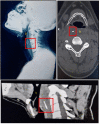Varied Manifestations of Sharp Penetrating Foreign Bodies in the Aerodigestive Tract: Our Experience
- PMID: 37366454
- PMCID: PMC10290822
- DOI: 10.7759/cureus.39525
Varied Manifestations of Sharp Penetrating Foreign Bodies in the Aerodigestive Tract: Our Experience
Abstract
Introduction Foreign body ingestion or aspiration is an emergency dealt by otorhinolaryngologists. It is most common among children and the geriatric population. It paves the way for critical morbidity when prompt treatment is not initiated. Therefore, in the absence of strong evidence to guide decision-making, all suspicious presentations of the ingested sharp foreign body need to be kept in mind while making a diagnosis. Hence, our study is aimed to document the varied manifestations of sharp penetrating foreign bodies in the aerodigestive tract. Materials and methods The medical records of 40 patients who presented with sharp foreign body ingestion/aspiration in the department of otorhinolaryngology in our centre from September 2012 to September 2022 were reviewed retrospectively. Results In all 40 patients, we were able to retrieve the foreign body as such without crushing or breaking it. In our study, the most common foreign body retrieved among middle-aged and elderly were chicken bone (22.5%) or fish bone (25%), and the most common foreign body following accidental ingestion in children were stapler pins (20%). Conclusion The findings of our study concluded that relevant clinical history, atypical presentation, and radiological imaging of sharp penetrating foreign bodies in the neck should be addressed with the utmost caution, as foreign bodies migrate to deep neck space and bronchus and can result in untoward complications. Hence, we need to be suspicious of the varied manifestation of aerodigestive tract foreign bodies for early diagnosis and prompt treatment.
Keywords: aerodigestive tract; aspiration; foreign body; ingestion; sharp penetrating; sharp penetrating foreign bodies.
Copyright © 2023, V et al.
Conflict of interest statement
The authors have declared that no competing interests exist.
Figures



References
-
- Diagnosis and management of upper aerodigestive tract foreign bodies. Digoy GP. Otolaryngol Clin North Am. 2008;41:485–496. - PubMed
-
- Retropharyngeal abscess caused by a traumatic perforation of the hypopharynx by a fishbone. Berger S, Elidan J, Gay I. Ann Otol Rhinol Laryngol. 1990;99:927–928. - PubMed
-
- Impacted foreign body of retropharyngeal space. Gupta KR, Kakar PK, Saharia PS. J Laryngol Otol. 1972;86:519–521. - PubMed
-
- Foreign bodies in the aerodigestive tract in pediatric patients. Higo R, Matsumoto Y, Ichimura K, Kaga K. Auris Nasus Larynx. 2003;30:397–401. - PubMed
LinkOut - more resources
Full Text Sources
